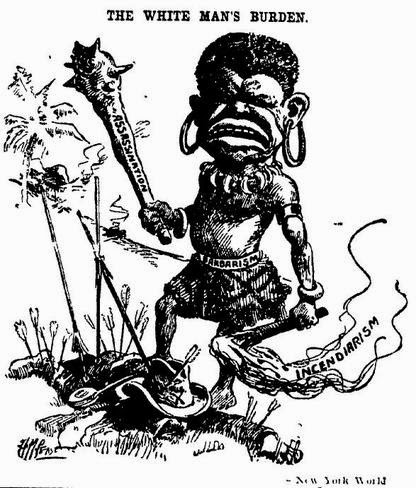My artifact is a handkerchief that was made to commemorate the Diamond Jubilee of Queen Victoria, an event that marked the sixtieth anniversary of her reign. The handkerchief is made from linen and is embellished with a black roller print design, indicating that it was probably mass-produced to be bought by all socio-economic classes. The design of the handkerchief depicts the British Empire and her various technological inventions through a series of icons laid out in concentric circles. Outside the outermost circle are coats of arms representing the imperial holdings of Canada, India, Australia, and Africa. Within the outermost circle are icons symbolizing the major industrial inventions of the nineteenth century. The inventions represented here include the railroad, the printing machine, the telegraph, the Maxim gun, and the battleship, the HMS Majestic. Finally, the innermost circle depicts Queen Victoria herself.
Context
The imagery on the handkerchief tells a triumphant story of British imperial might. First, the design of concentric circles evokes the globe, a reminder that British power extended to all corners of the earth in 1897. By having Queen Victoria in the center circle and the British colonies at the periphery of the outer circle, the handkerchief reinforces the idea that Queen Victoria—and, by extension, Great Britain—was the central authority overseeing the far reaches of the British Empire. The outer circle, which depicts British technological innovations, gives a sense of how British power was maintained despite the vast oceans separating England and her colonies. The telegraph and printing press, for instance, opened more efficient lines of communication between England and her imperial holdings. As the historian Ronald Hyam notes about the telegraph in particular, “The one triumphantly unifying factor [of the empire] was cable construction...: ‘the nerves of the empire’, by the 1890s, girdled the world with 121,000 miles of telegraph wires.” In a similar manner, technologies of travel such as the railway strengthened British power abroad by making it easier for government agents and soldiers to reach colonial outposts quickly and efficiently. The Maxim gun and the HMS Majestic shown on the handkerchief symbolize the unrivalled military might of Britain during this time period. For instance, the Maxim gun, a machine gun described as “frightfully destructive” by its inventor, changed the face of imperial warfare. Emily S. Rosenberg observes that the gun “emerged as a potent weapon in ‘little wars’ that were fought on colonial frontiers, where small British forces sought to imprint their authority over large areas and the substantial armies that tribal leaders could muster.” In sum, this commemorative handkerchief functions as a piece of imperial propaganda. It celebrates territorial conquests made by Britain, and details those inventions which permitted the further expansion and consolidation of the British Empire.
 |
| The Maxim machine-gun was adopted by the British Army in 1889. |
How Does it Relate to Nineteenth-Century Literature?
The handkerchief’s representation of imperial might, I believe, resonates with Rudyard Kipling’s depiction of empire in “The White Man’s Burden.” Kipling alludes to the violence involved in maintaining imperial power when he writes, “Take up the White Man’s burden--/ The savage wars of peace” (lines 17-18). Similarly, the Maxim gun and the HMS Majestic on the handkerchief reminds one of the horrific violence and destruction involved in maintaining British authority over her colonies. Furthermore, I see a relationship between Kipling’s depiction of colonized people as “silent” (line 47) and the fact that Africa, India, Australia, and Canada are represented by their coats of arms on the handkerchief. By representing these territories by their British-bestowed symbols, the handkerchief works to “silence” the voices of colonized people. In other words, the indigenous cultures of Africa, India, Australia, and Canada are not represented in the handkerchief’s narrative of empire; rather, these cultures are symbolically assimilated into British culture and British political structures. However, there is a crucial difference in tone between Kipling’s depiction of empire and the handkerchief’s. Where Kipling appears to critique practices of imperialism in his poem, the handkerchief unapologetically celebrates empire and imperialism.
Works Cited
- Ronald Hyam, Understanding the British Empire (Cambridge: Cambridge University Press, 2010), 19.
- Qtd. in J. Bucknall Smith, “Illustrated Interviews: No. XXXVIII—Mr. Hiram S. Maxim,” The Strand Magazine, 8 (July-December 1894), 584.
- Emily S. Rosenberg, A World Connecting: 1870-1945 (Cambridge, MA: Harvard University Press & C.H. Beck Verlag, 2012), 359.
More Information
Handkerchief.
Creator unknown. Made in Britain, 1897. Found on ArtStor.org.
From: The Metropolitan Museum of Art


No comments:
Post a Comment